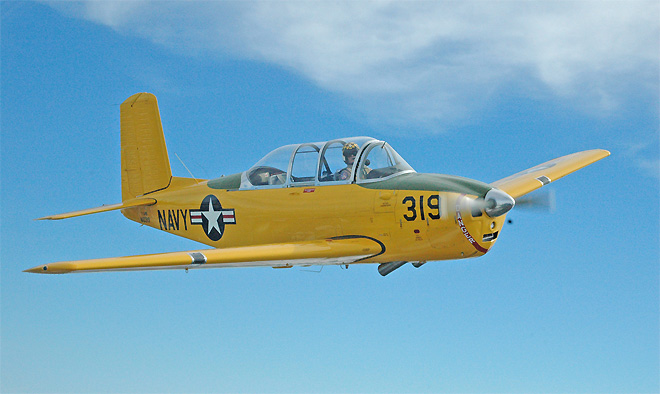|
|
||
|
T-34 'Mentor' |
|
|
|
The T-34 design itself was developed from the single-engine, piston-powered Beechcraft Model 35 "Bonanza" and designed under the project name of "Beechcraft
Model 45". The design was accepted by the United
States military and introduced in 1953. The first
operator became the United States Air Force
receiving the T-34A model. The United States Navy
became the next operator in 1955 and accepted the
slightly-modified T-34B into service. Design of the T-34 was wholly conventional. The engine was mounted to the extreme front of the fuselage, followed by the tandem-seat cockpit. The student pilot and instructor sat under a bubble canopy offering up excellent visibility in all quadrants. Wings were low-mounted monoplanes and unswept, clipped at the tips, and fitted just under the cockpit and sported some dihedral (upwards angle). The tail was equally conventional and made up of a single vertical tail fin with little to no sweep. The tail fin was complimented by a pair of horizontal planes. The aircraft sat on a tricycle undercarriage with two single-wheeled main landing gear legs retracting under each wing and a single-wheeled nose landing gear leg retracting rearwards under the engine compartment.  The T-34 series was widely exported to a variety of American-friendly customers, most centered in Latin and South America. In her military guise, this included Algeria, Argentina, Bolivia, Canada, Chile, Colombia, Dominican Republic, Ecuador, El Salvador, France, Gabon, Greece, Indonesia, Japan, Mexico, Morocco, Peru, Philippines, Taiwan, Spain, Turkey, Uruguay and Venezuela. Chile and Turkey (along with the US) became civilian operators of this fine aircraft. The T-34 series was widely exported to a variety of American-friendly customers, most centered in Latin and South America. In her military guise, this included Algeria, Argentina, Bolivia, Canada, Chile, Colombia, Dominican Republic, Ecuador, El Salvador, France, Gabon, Greece, Indonesia, Japan, Mexico, Morocco, Peru, Philippines, Taiwan, Spain, Turkey, Uruguay and Venezuela. Chile and Turkey (along with the US) became civilian operators of this fine aircraft.Despite her 1950's origins, the T-34 is still used to train USN and USMC aviators. As of this writing, her numbers are dwindling by the year as her replacement - ironically the Beechcraft/Raytheon T-6 "Texan II" - appears ready to take the mantle. Civilian demonstration teams such as the Hooligans have put the T-34 airframe to good use as well.* *Source: militaryfactory.com |
||